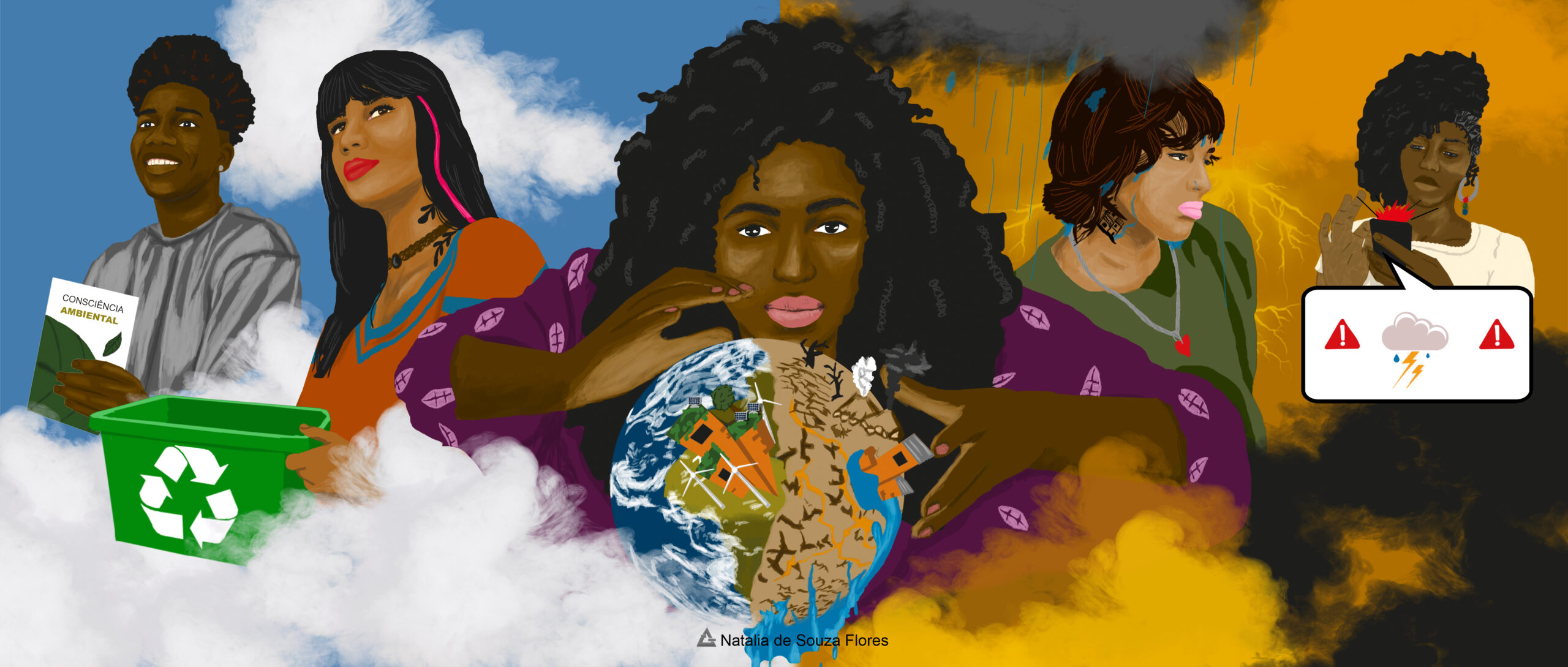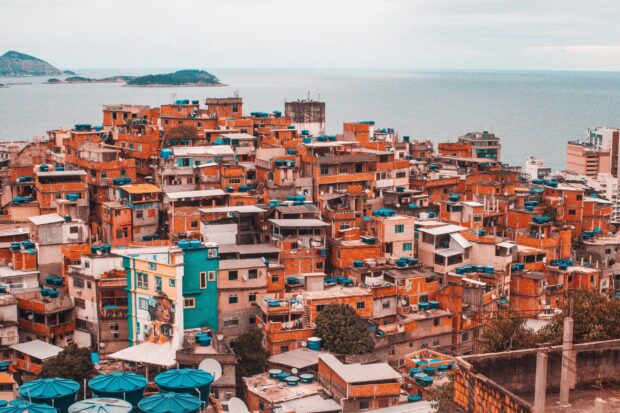

This is our latest article in a series created in partnership with the Behner Stiefel Center for Brazilian Studies at San Diego State University, to produce articles for the Digital Brazil Project on climate change in the favelas for RioOnWatch.
“It’s not everyone who has messed it up. There are a few, and to be able to save the planet we have to take up the fight against them and their companies and their money and hold them accountable.” — Greta Thunberg
Taken from the book Our House Is on Fire, Greta Thunberg’s words are impactful in even the most diverse of circumstances. The young Swedish activist who—at age 16—inspired thousands of children around the world to demand immediate action to fight climate change, reminds us of the urgency to think of pragmatic ways to prevent global warming and reverse climate change while there is still time.
However, a point that is seldom considered when it comes to sustainability is: how do these discussions affect informal settlements? How does this issue reach these spaces? In Brazil this election year, did candidates include favelas in the environmental agenda? There are many questions and yet few solutions to this scenario. Favelas are already affected by varied climatic extremes and disasters that directly affect the normal functioning of a community, causing material losses and damage to the environment and health of the population. In Rio de Janeiro, the torrential rains that devastate our state are an example. People suffer immensely because Rio is not yet a resilient city and—since its favelas are even less resilient—favela residents experience the worst consequences.
When thinking about resilient favelas, we first need to project futures for these areas. Imagine if the tables turn? That’s right, imagine that you are in the year 2070 and climate change has raised sea levels to such an extent that Rio’s South Zone is uninhabitable. In this context, only the highest parts of the city—which are more likely to be occupied by favelas—will be habitable. What do you suppose would happen? Where would the people who live in these spaces go?
This hypothetical scenario may become a reality. According to the Intergovernmental Panel on Climate Change (IPCC), average sea level could rise from 24-32cm by 2050 due to warming ocean waters and melting glaciers around the world. And here in Rio, the waters may warm up more or less than the global average, due to local factors and measures adopted by municipal, state, and federal governments.
It may seem like a small increase, but when combined with extreme weather events such as storms, even small differences can have devastating effects. A sea that’s a few centimeters higher would already mean that on days where there is a high tide, waves could flood and destroy much of the coastal zone.
By as early as 2025, 410 million people in communities in Asia will suffer from the risk of flooding due to rising sea levels. There are several projections of this future climate. One such projection, which is featured in the Climate Change Adaptation Guide—developed by WWF Brazil—outlines a scenario for the year 2100. In the report it is possible to visualize the impacts that the Brazilian regions will suffer in the coming decades. In the Southeast, we have the daunting scenario of a temperature increase between 1 and 8°C, a sharp reduction in rainfall during the rainy season, and the intensification of winds. This combination of factors will increase the risks of frequent urban flooding and landslides in hillside areas, lead to shortages and higher food prices, increase the number of heat waves and impact water supply and quality for the population. In addition, the region will experience an increase in the number of urban heat islands and blackouts in areas that suffer chronically from energy injustice.
All these factors place the population of favelas on the front line of this environmental crisis in Brazil. Historically, it is primarily European nations, the US, and more recently China that have been responsible for the carbon emissions that lead to climate change, having developed over centuries through environmental extraction. If nothing is done, the results of this predatory development by global elites will fall on the most vulnerable citizens of developing countries. We may see a similar situation to what happened with the race for vaccines during the coronavirus pandemic. Rich countries bought all the doses for themselves as quickly as they could, while poor countries suffered (and still suffer) from chronically delayed vaccine deliveries. Considering this inequality between countries, what are the chances of seeing success in mitigating the impacts of climate change?

What Needs to be Done?
For favelas to become resilient to disasters, services and infrastructure must be provided, adapted, and organized. Residents in areas prone to landslides and flooding need to be offered options through public policies that prioritize the safety of residents and guarantee their right to remain if this is their wish.
In addition, the government needs to take competent, inclusive, and transparent action in the favelas, with the active participation of the local population. The government must show concern for sustainable urbanization and invest public resources in disaster management. Governmental preparation for extreme weather events must be better organized, with planned responses before, during and after such incidents.
A resilient favela is also created through environmental education of the population. When residents understand the risks they face, they are better able to develop self-organized processes to raise awareness and mitigate the effects of the climate crisis. And by building on experience from the environmental disasters they have faced in the past—through partnership with authorities that respect their powers—residents will be able to come up with effective local solutions to systemic problems. In contrast to the historic neglect by the state and the top-down approach of their actions toward the favelas, this recognition, respect, and investment in local processes is key to dealing with the climate crisis. True and full participation in decisions and urban planning, working together with public authorities, is a precondition to building climate resilient favelas.
When we talk about these climate futures in the favelas, we have to be able to get ahead if we are to mitigate potential consequences. This can be done by incorporating monitoring technologies and early warning systems for the protection of people and infrastructure. The creation of physical locations to provide the best possible shelters for future victims of such events needs to be thought of right away. A set of immediate construction strategies must be put in place to fully establish basic services, including social, institutional, and economic activities in the favelas. At the same time, strategies to re-establish these services in cases of people affected by extreme weather events also need to be put in place. When it comes to responding to the climate crisis, favelas must be a priority.
About the author: Cleyton Santanna holds degrees in journalism and screenwriting from UFRRJ and the CriaAtivo Film School. He uses his YouTube channel to address oddities, ancestry, and Afro-Brazilian culture. In 2017, he produced two documentaries: “Entre Negros” (Between Blacks) and “Tudo Vai Ficar Bem” (Everything is Gonna Be OK), and was recognized as a screenwriter in 2018 by the Creative Economy Network for the short “Vandinho.” He is currently a communicator for the Museum of Tomorrow and hosts the Influência Negra podcast.
Natalia de Souza Flores, born and raised in Rio’s North Zone, is a member of the Brabas Crew. With a degree in Graphic Design from Unigranrio in 2017, she has worked as a designer since 2015. She launched a magazine of collective comics called ‘Tá no Gibi’ in 2017 at the Rio Book Biennial. Her main themes are based in African culture, using cyberpunk, wicca and indigenous elements.
